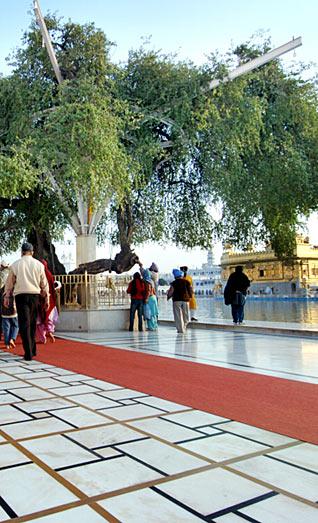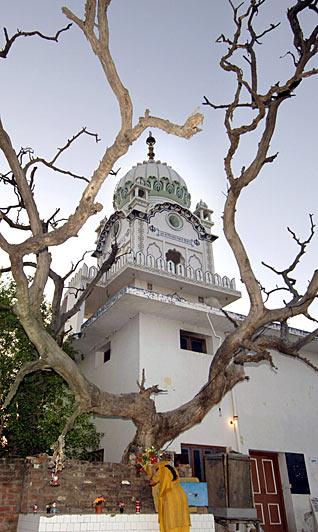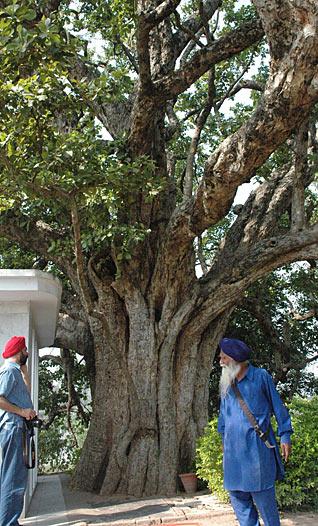Architecture
Deep Roots, Broad Branches
by PURVA GROVER & RAMESH VINAYAK"My God has breathed His light into the dust and so brought the world into being. It is He who created the sky, the earth, the waters, and all vegetation," reads a verse in Guru Granth Sahib where Guru Nanak sings of his love for Nature.
It is a universally known truth that Guru Nanak perceived a divine manifestation in every aspect of Nature.
On their far-flung travels to spread the good word, the Sikh Gurus continued with this message over a span of two centuries, and also found respite in trees wherever they went to conduct their religious discourses - meditating or resting beneath them, for example.
Long after they left, the trees were marked and remembered for their association with the visiting Gurus and often commemorated alongside the respective shrines that sprang up in memory of their sojourns.
For some time now, Damanbir Singh Jaspal, a Punjab-cadre senior Indian Administrative Service officer, has been studying the link between the ancient trees across the land and the Gurus.
"The idea was to explore the roots of our Sikh heritage and its repeated tryst with trees and Nature. In fact, a lot of people do not even know that some of our most revered gurdwaras are named after trees," says the seasoned bureaucrat.
Damanbir Singh's duties as Principal Secretary, Information, Public Relations & Financial Commissioner (Forests) - for the Government of Punjab - has helped him find fodder for his exercise.
"Be it in the form of a meditation aid or a source of nourishment for Man or horse (e.g., jand leaves), or a source of timber (tahli), trees have always figured prominently in the Sikh Faith," he says.
To establish this link, Damanbir has traveled across the State of Punjab and beyond, with his Nikon camera and captured on film 17 different species that have 48 of the most historical Sikh shrines named after them.
His completed documentation, now compiled into a book called Tryst with Trees: Punjab's Sacred Heritage, includes photographs and descriptions of the gurdwaras, and a write-up on the botanical features of each tree and its link with the shrine.
"While my travels helped me understand the history behind the old trees, it was my meeting with the people associated with the gurdwaras that made my mission most interesting and rewarding," he explains.
The president of the Neem Sahib gurdwara in the Akar village of Patiala related to Damanbir an incident wherein the great Maharaja Ranjit Singh bowed in reverence before a frail old man reputed to be close to being a centenarian - only because the latter had once actually seen Guru Gobind Singh! "And to think that today, the 400-year old neem tree at this gurdwara is the only living creature that has seen the Guru!" exclaimed the gurdwara administrator.
Traveling over 20,000 km over the course of his research, Damanbir's study has mostly been confined to Punjab. But a captivating document from outside the State is that of a lone neem tree in Leh (in Himalayan Ladakh). Legend has it that it sprouted from a daatan (sprig) planted by Guru Nanak in 1517, after he finished brushing his teeth with it.
Damanbir's major concern now is the real threat that some of these historical trees face from builders and renovators of gurdwaras.
For instance, the Tahli at the Santokhsar gurdwara near the Durbar Sahib and associated with Ram Das, the Fourth Guru and the Founder of Amritsar, was cut recently down to make way for a new, large marble-clad building.
Then, the tamarind tree at Imli Sahib gurdwara at Chamkaur Sahib was put to the axe in 2005 by the karseva jathaa in order to erect a new structure in its place.
"People must create awareness about these historical trees or coming generations will remember these shrines not by their trees, but by the marble," states Damanbir.
Still, there's hope in the form of the 450-year-old tahli tree at Gurdwara Tahli Sahib, Nawanshahar. Damanbir points to a picture of a tree branching out through three holes punctured through the ceiling of the gurdwara, and says: "The management created a new building there without causing any damage to the tree."
Incidentally, Damanbir Singh Jaspal is also President of an NGO called Chandigarh Nature and Health Society, which has undertaken the task of preserving these trees of sacred memory through modern technology.
The project titled "Clonal Propagation of Selected Sacred Species" has, by means of an experiment, obtained stems of four of the most important trees associated with historical gurdwaras: the Dukh Bhanjani Beri, Baba Buddha Beri, and Lachi Ner Beri (all located on the precincts of the Durbar Sahib in Amritsar), and the tree at Gurdwara Ber Sahib in Sultanpur Lodhi.
Call it a small step in tissue-culture, but certainly a giant leap for the preservation of our rich heritage!
[Courtesy: Simply Punjabi]
Photos by Damanbir Singh Jaspal - Front Page and Top of this Page: Ber Baba Buddha ji, Durbar Sahib, Amritsar. Bottom photo: Gurdwara Luhura Sahib, Lahore, Pakistan. Second from bottom: Gurdwara Kalp Vriksh, Ropar. Third from bottom: Gurdwara Tahli Sahib, Hoshiarpur.
Thumbnail: Photo of Damanbir Singh Jaspal.
Conversation about this article
1: Laurie Bolger (New York, NY, USA), April 11, 2007, 2:32 AM.
How amazing it is that a tree which "saw" Guru Gobind Singh is still alive today. It's unusual to think of a tree as a "creature", but, of course, that's exactly what it is, as much as we ourselves are. It is very laudable that this type of initiative is being undertaken. Perhaps I am mistaken, but I believe Bhagat Puran Singh also made tree conservation (as well as other environmental issues) a priority of his - advocating that people should not only try to prevent trees from being cut down, but should take an active part in planting pipals, neems, etc. So Damanbir Singh is in very august company in this regard.
2: S. Kaur (London, UK), May 03, 2007, 8:17 PM.
I was curious if anyone had any information of where one can purchase this book?
3: Bawa Preet Ranjan Singh (New Delhi, India), July 18, 2007, 4:41 AM.
Great article. My grandfather, Bawa Kartar Singh (who was head of the Chemistry department in Ravenshaw College in Cuttack, Orrisa, India, from 1921 till 1935) visited Gurudwara Daatan Sahib on the outskirts of Cuttack. Legend has it that it sprouted from a daatan (sprig) used by Guru Nanak, after he finished brushing his teeth with it. On reaching there, my grandfather saw a dilapidated structure which was then under the control of some mahants (Hindu priests). A branch of the tree had fallen and had been kept in a corner. By 1930, he managed to collect funds and had the Gurdwara rebuilt and refurbished. Three pieces of the broken branch were saved. One was sent to Khalsa College in Amritsar, the second was kept at the Botanical department of Ravenshaw College, and the third was kept in the Gurudwara itself. He then organised the local sangat, and had them take over the affairs of the Gurudwara. I learnt of all of this when I visited it some thirty years ago.
4: Jaswinder Singh Rekhi (Chandigarh, Punjab), January 15, 2009, 10:45 AM.
I appreciate your efforts in writing about the importance of "trees" in the Sikh world.
5: Sandeep (Bangkok), January 26, 2009, 7:10 AM.
You can check out www.trystwithtrees.com and buy the book. It's a masterpiece!
6: Tanya (Noida, India), March 08, 2009, 12:03 PM.
Had an opportunity to see the preview at www.trystwithtrees.com. Now eagerly waiting to see the real thing!
7: Dr. Rajinder Singh (Oldenburg, Germany), July 15, 2010, 11:32 AM.
Dear S. Bawa Preet Ranjan Singh: Being a historian of science, I would like to know more about Prof. Bawa Kartar Singh. You may contact me at - rajinder.singh@uni-oldenburg.de
8: Rajinder Singh (Oldenburg, Germany), July 13, 2018, 1:21 AM.
Book Review of "Deep Roots, Broad Branches" is an excellent piece of work, telling the pain-staking work done by the author Damanbir Singh for writing his book on the importance of trees and their link with Sikhism. What a shame that Gurdwara administrators destroy such trees for the sake of "architecture" work. Any good architect is in the position to make a new building in such a way that old trees or buildings can kept as they are. Any way, majority of the adminstrators who take/took care of Sikh gurudwaras are/were never very learned or sophisticated. Hopefully, one day new the young generation will protest against such people.






